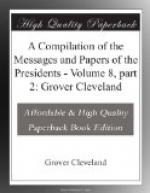It is a matter for congratulation to know that the Secretary will not spare any effort to make this part of his work thoroughly useful.
In the year 1839 the Congress appropriated $1,000, to be taken from the Patent Office funds, for the purpose of collecting and distributing rare and improved varieties of seeds and for prosecuting agricultural investigations and procuring agricultural statistics. From this small beginning the seed division of the Department of Agriculture has grown to its present unwieldy and unjustifiably extravagant proportions.
During the last fiscal year the cost of seeds purchased was $66,548.61. The remainder of an appropriation of $135,000 was expended in putting them up and distributing them. It surely never could have entered the minds of those who first sanctioned appropriations of public money for the purchase of new and improved varieties of seeds for gratuitous distribution that from this would grow large appropriations for the purchase and distribution by members of Congress of ordinary seeds, bulbs, and cuttings which are common in all the States and Territories and everywhere easily obtainable at low prices.
In each State and Territory an agricultural experiment station has been established. These stations, by their very character and name, are the proper agencies to experiment with and test new varieties of seeds; and yet this indiscriminate and wasteful distribution by legislation and legislators continues, answering no purpose unless it be to remind constituents that their representatives are willing to remember them with gratuities at public cost.
Under the sanction of existing legislation there was sent out from the Agricultural Department during the last fiscal year enough of cabbage seed to plant 19,200 acres of land, a sufficient quantity of beans to plant 4,000 acres, beet seed enough to plant 2,500 acres, sweet corn enough to plant 7,800 acres, sufficient cucumber seed to cover 2,025 acres with vines, and enough muskmelon and watermelon seeds to plant 2,675 acres. The total quantity of flower and vegetable seeds thus distributed was contained in more than 9,000,000 packages, and they were sufficient if planted to cover 89,596 acres of land.
In view of these facts this enormous expenditure without legitimate returns of benefit ought to be abolished. Anticipating a consummation so manifestly in the interest of good administration, more than $100,000 has been stricken from the estimate made to cover this object for the year ending June 30, 1895; and the Secretary recommends that the remaining $35,000 of the estimate be confined strictly to the purchase of new and improved varieties of seeds, and that these be distributed through experiment stations.
Thus the seed will be tested, and after the test has been completed by the experiment station the propagation of the useful varieties and the rejection of the valueless may safely be left to the common sense of the people.




